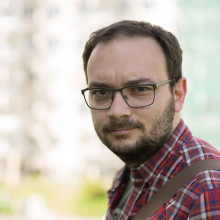Polish literature

Filip Springer
(born 1982) is a photographer and reporter who has received many of Poland’s prestigious literary awards. He holds a degree in archaeology from the Adam Mickiewicz University in Poznań. His photographs have been shown in solo exhibitions in many Polish cities.
He introduced a new topic into Polish reportage: architecture. In his first book, his well-acclaimed debut Miedzianka: The Story of a Disappearance [Miedzianka. Historia znikania] (Czarne, 2011), he described the history of a small town in Lower Silesia which disappeared from the face of the earth in a short period of time. It’s not only a reconstruction of the fates of its residents – Germans, Poles, Russians and Romani – but also a story about the mark which history leaves on the lives of ordinary people, and how a person influences his/her surroundings: mines operated for centuries in Miedzianka and completely destroyed the environment. A gradual, constant devastation of the city accompanied historical changes, until the town finally, almost literally, dropped beneath the earth. The author excellently conveys the process of a slow erosion, of destruction; in a series of freeze-frames he preserves images of the space as it transforms: houses falling into ruin and trees collapsing, and the deceitful eviction of the town’s residents, who were condemned to disappear by the authorities.
As much as architecture serves as an important background in Miedzianka for a description of human fates, it becomes the main protagonist in subsequent books by this author (Ill-Born: Polish Communist Architecture [Źle urodzone. Reportaże o architekturze PRL-u], Karakter 2012, Blueprints: The Life and Work of Zofia and Oskar Hansen [Zaczyn. O Zofii i Oskarze Hansenach] MSN and Karakter 2013, A Bathtub with a Colonnade: A Book of Reportage on Polish Space [Wanna z kolumnadą. Reportaże o polskiej przestrzeni] Czarne 2013). Springer writes about architecture from the position of its user – an ordinary resident and a common passerby – and thus extracts it, in a sense, from the sphere of specialists, architects and town planners. The author begins with basic questions, such as: Why has communist-era modernist architecture aged so badly and why does it arouse such controversy? Why didn’t Polish architects hear about Oskar Hansen during their studies? Why is the space we live in so ugly? He then discusses not only architecture but also the economic and social mechanisms which in various ways – depending on the time and place – determine its function and final form.
The reporter is also interested in another aspect of architecture, which has often been used as a tool in shaping social relations and influencing human behaviour. This is certainly why particular attention was given to communist-era modernism, especially to the architect-visionary Oskar Hansen. In Blueprints, Springer broadens the context of the story in an engaging way, introducing a Scandinavian motif; with just a few strokes he shows how the social model adopted there is reflected in architecture and in people’s relations to the space surrounding them, and vice versa.
Springer’s books often contain an element of journalistic investigation; the author tracks down unknown testimonials and documents, and juxtaposes accounts by people who interpret the same events in different ways. This motif is clearly visible in Miedzianka, but also in a book with a more journalistic edge, A Bathtub with a Colonnade, in which the reporter attempts to reach people responsible for the illegal installation of large-scale advertising billboards on residential buildings.
An important element of Springer’s books are the photographs, which interweave with the text parallel to the developing story (Ill-Born and A Bathtub with a Colonnade). His photos are instantly recognisable: a cool colour scheme, melancholy distance, a natural pictorial quality and a hint of irony here and there. As he, himself, admits, he attempts to compose texts according to principles similar to those which govern photographic reportage; rhythm, detail and closer and more distant viewpoints operate in them in an analogous way. Although his books are devoted to concrete phenomena and architects, they always have a deeper, existential dimension, thanks to which they go beyond a casual description. Springer’s writing has been appreciated by both critics and readers – he is considered one of the most talented authors of his generation.
BIBLIOGRAPHY
- Miedzianka. Historia znikania, Wołowiec: Czarne, 2011
- Źle urodzone. Reportaże o architekturze PRL [Ill-Born: Polish Communist Architecture], Kraków: Karakter, 2012
- Zaczyn. O Zofii i Oskarze Hansenach [Blueprints: The Life and Work of Zofia and Oskar Hansen], Kraków: Karakter, 2013
- Wanna z kolumnadą. Reportaże o polskiej przestrzeni [A Bathtub with a Colonnade: A Book of Reportage on Polish Space], Wołowiec: Czarne, 2013
- 13 pięter, Wołowiec: Czarne, 2015
TRANSLATIONS
German:
- Kopfgeburten [Źle urodzone], transl. Lisa Palmes, Berlin: Dom Publishers, 2015
Gallery




